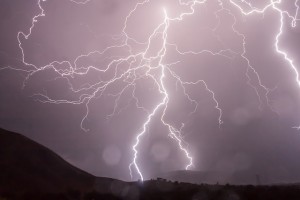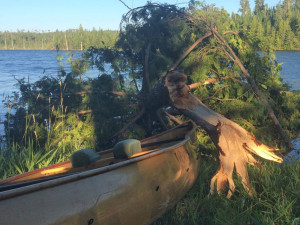On Thursday, June 12, 2014, a crew of eight originating from BSA’s Northern Tier base encountered 30 mph winds and heavy rain and waves while crossing a large lake in the Boundary Waters.

One of their three canoes swamped in the waves, putting three of the eight crew members in the cold water (the two adult leaders and a Scout). The crew members in the other two canoes were able to seek shelter on a nearby island after having been driven there by the winds and current.
Assistance was requested by radio, and all crew members were ultimately rescued hours later. The crew was able to pinpoint its position with a strobe light, which rescuers said was instrumental in being able to locate the crew along the heavily-forested shoreline (helpful hint there).
The local Sheriff’s Office stated “Weather conditions were less than favorable for being out on big water, and the high winds and big waves and big open water were not good conditions for boats, let alone canoes.” The air temperature was reported to be in the 40s. The water temperature was typical for June . . . cold.
This story has a favorable ending, due in no small part to the heroic efforts by a Northern Tier interpreter accompanying the crew, and the multi-jurisdictional rescuers who retrieved the crew from the storm, but that may be small consolation to those crew members who spent time fully clothed in the cold water under tough conditions trying to survive, not to mention being stranded on land under hypothermic conditions awaiting rescue.
A reminder to Northern Tier participants that:
(1) Northern Tier requires all crew members to wear boots while canoeing (to ensure proper footwear when portaging);
(2) Northern Tier requires participants to be pre-cleared for swim ability by the crew prior to arrival (no swim test is administered upon arrival);
(3) Northern Tier, for a complete crew of 9 (including the interpreter), places three crew members in three canoes (in part due to Boundary Waters crew size and boat number regulations) meaning the canoes are well loaded; and
(4) Northern Tier does not practice in-water swamping or canoe rescue skills prior to departure (crew members are expected to have adequate canoeing skills upon arrival).
If you have a crew attending Northern Tier for a canoe trek, it might be good to know (1) whether the crew members are comfortable swimming in boots if dumped into the water, (2) whether their swim skills in a cold lake match the pre-clearance form (particularly for adult advisers), (3) whether the crew is experienced with paddling canoes fully loaded with three crew members and their gear, and (4) whether the crew has the ability to self-rescue if one or more canoes swamps in heavy waves. Remember, we are dealing with youth here!
Or, would that be the first time a crew member was in a swamped canoe, while suffering the shock of suddenly being in cold water under stressful conditions? Lastly, did your crew’s canoe practice at home only involve two crew members in an unloaded canoe, or did your crew actually practice canoeing with three canoe members in a fully loaded canoe?
The story seems to suggest that once your crew swamps you may require and have available to your crew relatively immediate rescue assistance, but there will be circumstances when self-rescue is necessary. If the crew had not had a working radio, what would they have done? Was self-rescue part of the planning process? And, it is important to remember that no outside rescue can be immediate in the middle of a severe storm.
Interestingly, another Northern Tier crew miles away suffered a similar incident during the same storm, having two of three of its canoes capsize. Fortuitously, however, campers on a nearby shoreline were able to immediately assist the crew for the duration of the storm.
 But, sometimes disaster lurks on land at the Boundary Waters, as shown by this tragic 2016 story where two members of a BSA crew perished due to a falling tree, this 2016 story where falling trees injured campers, this 2014 story making clear the perils of storms + trees in the Boundary Waters, this 2016 story where several campers were injured by lightning, this 2016 story where two campers and their dog waited out a storm outside their tents to avoid falling trees, and this 2016 commentary by several campers regarding their Boundary Waters storm experience.
But, sometimes disaster lurks on land at the Boundary Waters, as shown by this tragic 2016 story where two members of a BSA crew perished due to a falling tree, this 2016 story where falling trees injured campers, this 2014 story making clear the perils of storms + trees in the Boundary Waters, this 2016 story where several campers were injured by lightning, this 2016 story where two campers and their dog waited out a storm outside their tents to avoid falling trees, and this 2016 commentary by several campers regarding their Boundary Waters storm experience.
Things to think about. Open water canoeing is not all about sunshine and calm water! And, camping in the wilderness can, by itself, be a challenge . . .
